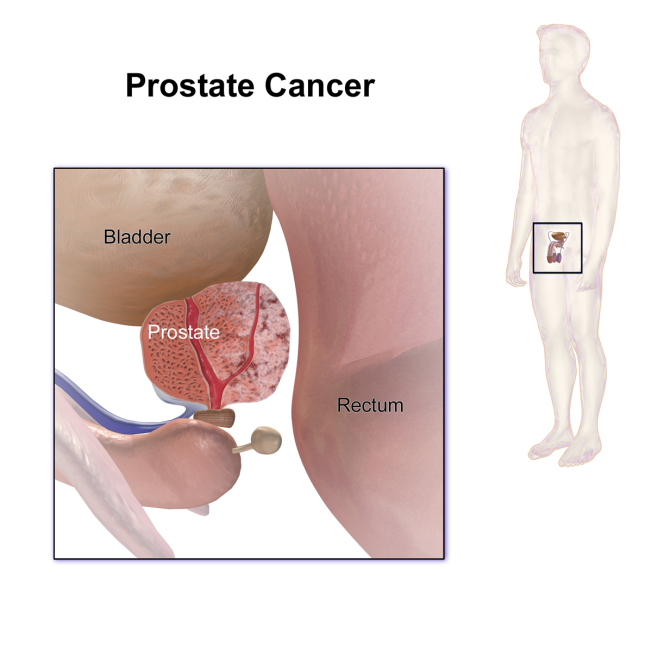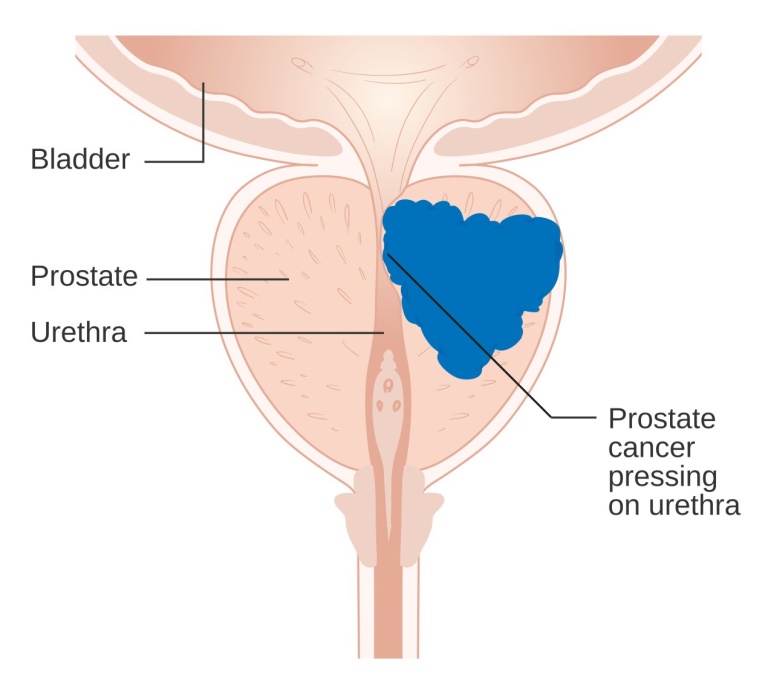Prostate cancer
Prostate cancer is marked by an uncontrolled (malignant) growth of cells in the prostate gland. The prostate is the walnut-sized gland in men, located just below the bladder and in front of the rectum, surrounding the urethra – the tube that carries urine out of the bladder. The prostate produces and stores fluid that helps to make semen, and is involved in regulating bladder control. Prostate cancer is the most common type of cancer found in men in the United State, aside from skin cancer, and often begins without symptoms. In 2018, the American Cancer Society estimates that 164,690 men will be newly diagnosed with prostate cancer, 29,430 will die from the disease, and 1 in every 9 men will be diagnosed with prostate cancer during their lifetimes. Prostate cancer can be slow-growing, such that many men die of other diseases before prostate cancer causes significant problems. However, many prostate cancers are more aggressive and can spread outside the confines of the prostate gland, which can be deadly. The prostate cancer survival rate is greatly improved with early detection and personalized treatment What causes prostate cancer? It is not yet known exactly what causes prostate cancer, but researchers are studying certain risk factors to determine if these factors contribute to prostate cells developing into cancer.
Who is at risk for prostate cancer?
Certain men are at higher risk than others for prostate cancer, which can affect once they should start being screened. The risk increases with age, particularly after age 50. Some risk factors include:
- African American men are twice as likely as white men to develop the disease.
- Having a family history – a father or a brother diagnosed with prostate cancer, particularly if it's at a comparatively early age – increases the danger.
- Having a case history of breast and ovarian cancer can also be related to an inherited risk of developing prostate cancer
- High-fat diet and/or obesity
- Smoking
- A sedentary lifestyle
However, there could also be measures to aid in the prevention of prostate cancer that can reduce risk, including regular exercise and diets low in fat and high in fruits, vegetables, and whole fibers. Foods with high amounts of the antioxidant lycopene – like tomatoes, grapefruit, and watermelon – may help to lower the risk. Additional prevention strategies are currently being studied.

What are the symptoms of prostate cancer?
In most cases, prostate cancer causes no symptoms. In rare cases, men may experience certain symptoms once they have advanced prostate cancer. However, these symptoms also are present in many men who don't have cancer, so it's best to discuss them with a doctor before jumping to any conclusions. a number of these symptoms can include difficulty emptying the bladder, blood within the urine, and bone pains. How is prostate cancer diagnosed? Prostate cancer screening consists of:
- Digital rectal examination - the doctor inserts a lubricated gloved finger into the rectum to see for lumps on the prostate
- Prostate-specific antigen (PSA) blood test - a blood sample is analyzed for levels of a protein produced by the prostate that, when elevated, can indicate the presence of cancer.
- New urinary (PCA3 and MDx Select) and blood (4K score and PHI test) biomarkers also are used sometimes to screen for prostate cancer in men considered to be at-risk for the diagnosis.
However, there could also be measures to aid in the prevention of prostate cancer that can reduce risk, including regular exercise and diets low in fat and high in fruits, vegetables, and whole fibers. Foods with high amounts of the antioxidant lycopene – like tomatoes, grapefruit, and watermelon – may help to lower the risk. Additional prevention strategies are currently being studied.

